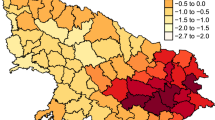Abstract
When linear, binary or count responses are collected from a series of (spatial) locations, the responses from adjacent/neighboring locations are likely to be correlated. To model the correlation between the responses from two adjacent locations, many existing studies assume that the two locations belong to a family and their responses are correlated through the random effects of common locations shared by them. In developing a correlation model for similar spatial responses, a recent study, however, used a much broader concept that the two selected neighboring locations have their own family and the correlation between the responses from these two locations are formulated by exploiting the correlations among the random effects belonging to both families. But, this study was confined to the linear spatial responses only. In this paper, we consider spatial count responses such as the number of lip cancer cases collected from a series of (spatial) locations, and develop a correlation model for spatial counts by following the recent pair-wise family-based spatial correlation model for the linear data. The correlation models for spatial linear and count responses are generally different. As far as the estimation of the parameters of the proposed correlation model for spatial counts is concerned, we develop a second-order moments-based GQL (generalized quasi-likelihood) approach for the estimation of the regression parameters, and a fourth-order moments-based GQL approach for the estimation of both variance and correlation of the random effects. It is demonstrated through an intensive simulation study that the proposed GQL approach works quite well in estimating all parameters of the underlying correlation model developed for spatial counts. The proposed model and the estimation methodology have been illustrated through an analysis of the well-known Scottish lip cancer data.
Similar content being viewed by others
References
Besag, J. (1974). Spatial interaction and the statistical analysis of lattice systems. J. R. Stat. Soc. Series B36, 192–236.
Breslow, N.E. and Clayton, D.G. (1993). Approximate inference in generalized linear mixed models. J. Amer. Stat. Assoc.88, 9–25.
Clayton, D. and Kaldor, J. (1987). Empirical Bayes estimates of age-standardized relative risks for use in disease mapping. Biometrics43, 671–681.
Cressie, N. (1993). Statistics for Spatial Data, Revised ed. Wiley, New York.
Cressie, N. and Read, T.R.C. (1989). Spatial data analysis of regional counts. Biometric. J.31, 699–719.
Davis, R.A., Dunsmuir, W.T.M. and Wang, Y. (2000). On autocorrelation in a Poisson regression model. Biometrika87, 491–505.
Ferrandiz, J., Lopez, A., Llopis, A., Morales, M. and Tejerizo, M.L. (1995). Spatial interaction between neighboring counties: cancer mortality data in Valencia (Spain). Biometrics51, 665–678.
Kaiser, M.S. and Cressie, N. (1997). Modeling poisson variables with positive spatial dependence. Stat. Probab. Lett.35, 423–432.
Kang, E.L., Cressie, N. and Shi, T. (2010). Using temporal variability to improve spatial mapping with application to satellite data. In: Sutradhar, B. C. (ed.) Special Issue, Canadian Journal of Statistics, pp 271–289.
Mallick, T.S. and Sutradhar, B.C. (2008). GQL versus conditional inferences for non-stationary time series of counts with overdispersion. J. Time Series Anal.29, 402–420.
Mariathas, H.H. and Sutradhar, B.C. (2016). Variable family size based spatial moving correlations model. Sankhya B78, 1–38.
McCullah, P. and Nelder, J.A. (1989). Generalized Linear Models. Chapman and Hall, London.
Osei, P.P. (2010). Statistical methods for disease mapping: an unpublished post graduate diploma essay. AIMS (African Institute of Mathematical Sciences).
Rathbun, S. and Cressie, N.A. (1994). A space-time survival point process for a longleaf pine forest in Southern Georgia. J. Amer. Stat. Assoc.89, 1164–1174.
Sutradhar, B.C. (2003). An overview on regression models for discrete longitudinal responses. Stat. Sci.18, 377–393.
Sutradhar, B.C. (2004). On exact quasi-likelihood inference in generalized linear mixed models. Sankhya B66, 261–289.
Sutradhar, B.C. (2011). Dynamic Mixed Models for Familial Longitudinal Data. Springer, New York.
Sutradhar, B.C. and QU, Z. (1998). On approximate likelihood inference in a poisson mixed model. Canad. J. Stat.26, 169–86.
Waclawiw, M.A. and Liang, K.-Y. (1993). Prediction of random effects in the generalized linear model. J. Amer. Stat. Assoc.88, 171–178.
Yasui, Y. and Lele, S. (1997). A regression method for spatial disease rates: an estimating function approach. J. Amer. Stat. Assoc.92, 21–32.
Zeger, S.L. (1988). A regression model for time series of counts. Biometrika75, 621–629.
Zhao, L.P. and Prentice, R.L. (1990). Correlated binary regression using a quadratic exponential model. Biometrika77, 642–648.
Acknowledgements
The authors would like to thank the reviewers for their comments and suggestions leading to the improvement of the paper.
Funding
This research was partially supported by a grant from the Natural Sciences and the Engineering Research Council of Canada.
Author information
Authors and Affiliations
Corresponding author
Rights and permissions
About this article
Cite this article
Wijekoon, P., Oyet, A. & Sutradhar, B.C. Pair-Wise Family-Based Correlation Model for Spatial Count Data. Sankhya B 81, 133–184 (2019). https://doi.org/10.1007/s13571-017-0150-1
Received:
Published:
Issue Date:
DOI: https://doi.org/10.1007/s13571-017-0150-1
Keywords and phrases
- Correlated random effects
- Count responses from correlated locations
- Family-based spatial correlations: Joint generalized quasi-likelihood estimation
- Normality-based higher order moments
- Random effects, their variance and correlations
- Spatial counts




